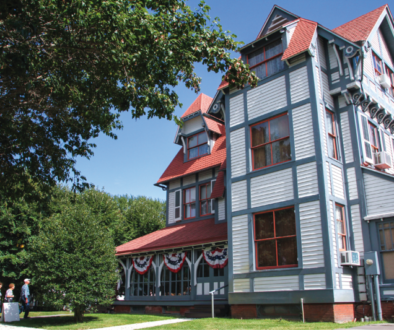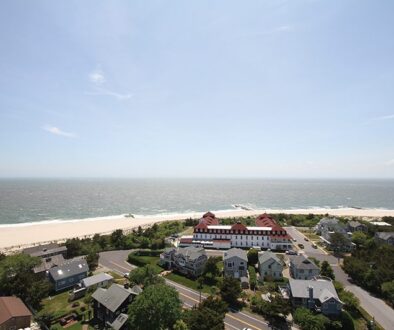Cape May MAC at 50: What Comes Next?
While most of the world huddled indoors, staying far away from their regular lives and even further from anything entertainment related, something pretty enormous happened in Cape May. Without any of the planned fanfare, without an in-person celebration, without the acknowledgement it surely deserved, Cape May MAC marked its 50-year anniversary.
In our last issue, we took a deep dive into the origins of MAC and the coinciding preservation designation of Cape May. And while the origin of MAC is important, and in fact of particular importance for an organization dedicated to preservation, it’s equally important to acknowledge what Cape May MAC does today and how it’s developed over the past 50 years. The Physick Estate, the well-known centerpiece of MAC, is really just the tip of the iceberg.



In fact, Cape May MAC’s reach is pervasive, far more extensive than anyone not intimately involved in the organization may realize. It’s very likely that if you’ve spent any time in Cape May at all, you’ve participated in a MAC event, or visited a MAC property. From field trips to romantic excursions to family friendly outings, MAC has been a go-to organization for Cape May activities, quite possibly without you knowing it, for the past five decades.
The depth and breadth of MAC’s history is on full display in Cape May MAC’s newest exhibit, titled “50 Years of MAC: 1970 to 2020.” The temporary exhibit, located in The Carroll Gallery on the grounds of The Physick Estate, was curated by Janet Coupland and designed by Jean Barraclough, who impressively managed to capture the people, the places, and accomplishments of MAC in a cohesive and visually impactful manner.
Organized around the five major eras in MAC’s history—Pioneer Phase, Adolescent Phase, Growth to Maturity Phase, Golden Age, and Shifting Tectonic Plates—the exhibit is anchored by a comprehensive timeline. In addition to the bulleted lists of significant events, there are corresponding photos and documents, sections on special events, particular places, and of course, the people behind it all.
“We wanted it to be very visual and impactful, and also focus on people,” says Coupland. “Not just Michael Zuckerman, our fearless leader, and the board, but all of the staff and volunteers, the lifeblood of MAC.”
The exhibit highlights MAC’s growth, and its people. From a small, grassroots group of passionate volunteers to an award-winning nonprofit organization with an operating budget in excess of $3 million in 2019, MAC has experienced extensive growth. According to a Cape May MAC fact sheet, the organization now boasts almost 300,000 visitors annually; 3500 members; a 15-member Board of Trustees; 25 full-time and approximately 125 part-time employees; and about 300 volunteers.
A perfect transitional piece, the exhibit also acknowledges the first leadership change it has experienced in 37 years with the retirement of Director Emeritus Michael Zuckerman, to whom the exhibit pays tribute.
Of all the accomplishments Zuckerman had during his tenure—and there are very, very many—a few of his proudest are “spearheading the cycle of changing exhibits in the Carriage House that explore different aspects of Cape May’s history and culture; launching the Cape May Music Festival as one of our region’s premier cultural offerings; and building out a year-round schedule of tours and special events that has significantly stretched the Cape May tourism season and serves nearly 300,000 people a year.”

Fortunately, Jody Alessandrine, who brings a wealth of knowledge and experience to the job, is now filling Zuckerman’s almost impossibly big shoes.
Alessandrine, a former executive director of special improvement districts in Toms River and State College, Pennsylvania, took over officially on February 24th, after shadowing Zuckerman on Fridays from November 2019 to January 2020 as well as a full week in February.
As a dues-paying member of MAC for the past 20 years, Alessandrine had a pretty firm grasp on everything related to the organization. However, as we all know now, he was also in the profoundly unique position of coming aboard during a worldwide pandemic.
“It’s very difficult stepping into the shoes of someone who has had such a stellar career,” says Alessandrine, noting that now, due to the Coronavirus, “The terrain is completely changed.”
For Cape May MAC, the Coronavirus and associated shutdowns have resulted in a proliferation of virtual tours and online outreach, as it’s done for many museums and organizations nationwide.
“There are things we may have gotten to, like the virtual tours, but this has fast-tracked us,” says Alessandrine. “The pandemic has forced us to pivot on a daily, even hourly, basis.”
Despite the challenges of managing a multi-faceted historic and entertainment organization at a time when everything remains so uncertain, Alessandrine is happy to be in his position.
“Our development team has done a wonderful job,” says Alessandrine. “I’m looking forward to the challenge of growing our endowment…despite the unique challenges, it’s still my dream job.”
The final wall of the exhibit is dedicated to another transition—a name change for MAC.
“MAC’s founders were ambitious, and its name (“Mid-Atlantic Center”), reflected their uncompromising and lofty goal: to make Cape May into a regional destination for culture, history and the arts, and preserve its historic integrity for generations,” according to Susan Krysiak, Director of Media Relations for MAC.
Coinciding with its 50th anniversary, MAC has changed its name from Mid-Atlantic Center for the Arts & Humanities (MAC) to Cape May MAC (Museums+Arts+Culture). It’s a bold move for an organization that manages and preserves the longevity and history of many parts of Cape May, and speaks to the ability of those behind the scenes at Cape May MAC to embrace change and adapt to a changing world.
“It had to do with an injection into the organization of young thinking. Eliza Lotozo started out in marketing. She had this incredible optimism that this could happen. She has a great sense of style and the ability to imagine, to re-imagine the organization and how it looks,” says Krysiak. “And I have to give credit to our board for their vision and for leading the project to completion. If there’s one thing I can say about [this organization], it’s that we’ll try something and see if it works. We have a great team approach and are open-minded when the spark is lit.”




“It allows us to take the whole of what we do and make it cohesive,” says Lotozo, Chief Outreach Officer, about Cape May MAC’s new identity. “There’s so much about MAC that’s important to the community. Since I have started, I’ve been really proud of the inner soul-searching the organization has done. After 50 years, to be able to redefine yourself, I don’t think that happens a lot.”
For those who already know and love MAC, the new name simply highlights what we’ve known: Cape May MAC is home to a bevy of cultural and historical entertainment. But for those who weren’t familiar with MAC, the new name will speak volumes. Clear and concise, it explains exactly what’s at the heart of Cape May MAC (Museums+Arts+Culture).
Cape May MAC may best be known for The Emlen Physick Estate, but it now manages four distinct properties—the Physick Estate, the Cape May Lighthouse, World War II Lookout Tower Museum and Memorial, and the Batts Lane Cottages. The organization hosts community tour programs that expose visitors to the city of Cape May, which Cape May MAC interprets as a museum without walls. Like the city, the other Cape May MAC properties need to be seen and heard, touched, and smelled.
When MAC started in 1970, it was done so, in many ways, as a passion project.
“The immediate threat of the demolition of the Physick Estate was a wakeup call to a sleepy but certainly beloved community that was ‘somewhere in time,’” says Tom Carroll, who in addition to being involved with Cape May MAC since its inception, is the current Board President, a role he also held from 1985 to 1987 and again from 1998 to 2000. “It signaled a fast approaching storm of redevelopment and modernization, as seen in Wildwood, to make money for some while destroying a quality of life for many others. It was certainly a call to action.”
The Physick Estate was the impetus, but the second Cape May MAC maintained property was the Cape May Lighthouse. Built in 1859, the lighthouse was leased to MAC by the State of New Jersey Division of Parks and Forestry, Department of Environmental Protection, in 1986 before being renegotiated and extended in 1995 and 2019, respectively. Cape May MAC manages restoration, maintenance, and operation of this working lighthouse and grounds, with over 75,000 annual visitors.
In 2004, MAC executed another lease with the state—this time, a 20-year lease for the World War II Lookout Tower on Sunset Boulevard. MAC undertook restoration of the tower and opened the World War II Lookout Tower Museum and Memorial in the spring of 2009. With a changing exhibit gallery on the second level, the property receives nearly 10,000 visitors annually.
The most recently property acquired—the only one owned rather than leased by Cape May MAC—are the Batts Lane Cottages, which were donated to MAC in August 2019 by owners Dave and Chris Clemans. This new acquisition has been featured on the Underground Railroad Trolley Tours since 2017, in cooperation with the Center for Community Arts.
Though focused on preservation, the addition of properties is something that is considered very thoughtfully.
“We have to be really thoughtful about what we extend into,” says Krysiak. “We don’t have limitless resources, and we have to be good stewards of what we take on. Maintaining the properties is ongoing.”
Tour programs are varied and range from the general to the highly specific. From a Cape May Trolley Tour of the Historic District and a Grand Lighthouse Cruise in partnership with Cape May Whale Watcher, to a Sherlock Holmes Weekend and Search for Clues and a tour package with the new Harriet Tubman Museum, there is quite literally something for everyone.
Consider the second word in Cape May MAC’s new acronym: Arts. The word is expansive and can include anything from the visual arts—paintings, sculpture, ceramics, architecture, photography and more—to the performing arts—public speech, music, dance, theater, and interpretive performance. And at Cape May MAC, it does all of that.
The ‘Arts’ are integral to much of Cape May MAC’s programming. There are events that are clearly arts inspired, like “Shakespeare on the Estate” in conjunction with REV Theatre Productions, and “Bach’s Lunches” held during the Cape May Music Festival. Then there are events like “The Art of Dining,” a public program at the Physick Estate, and the “Craft Beer, Music & Crab Festival,” a Cape May MAC fundraiser for educational outreach, that immerse guests into other art forms.
There’s a case to be made for the artistic value of so many Cape May MAC events, lectures, and tours—even events like the beloved Christmas Candlelight House Tours expose visitors to the architecture and history of Cape May, as well as traditional and vintage holiday décor—that it’s hard to determine where ‘art’ ends and ‘culture,’ the third word in the new Cape May MAC acronym, begins.
“Changing our acronym to be redefined this way gives clear descriptive words for people to understand what we do. On the one hand, some are clear cut things, but many are all three,” says Lotozo. “The overlap is one of our core challenges. So much of what we do is intersectional.”
The cultural programming at Cape May MAC is just as comprehensive and encompassing as the arts and museums.
The word “culture” has multiple definitions, and culture alone could define Cape May MAC. In a region that isn’t known for being a hotbed of culture, Cape May MAC is especially important in Cape May County, where history and the arts often seem to take a backseat to the beach, the boardwalks, and the nightlife so important to a tourism economy.
Cape May MAC programming acquaints visitors to culture as an almost daily occurrence. With preservation as a backbone to Cape May MAC, history and different cultural periods in our nation are par for the course. In addition to the tours and museums, many of which speak to a certain period of time, there are specific programs that dig into cultural themes. Past programs like “A Day in the Life with Dr. Physick” and “The Temperance Debate” at The Physick Estate; “The Keeper’s on Duty” at Cape May Lighthouse; and dozens of educational programs related to Victorian Social History and Culture including American Literature of the Victorian Era; Victorian Love, Courtship and Marriage; and Victorian Medicine all speak to culture as a certain period in time.
But there is also culture as it relates to community and the arts. The inclusion of music programs—both historical dives like “The Big Band Era” or “Music of Olde Cape May” and live music from local artists—exposes those of us tucked away in our limited worlds to things and sounds outside ourselves and our everyday lives.
It’s the same with the gourmet food and tastings, the craft shows, the lectures, the ghost tours, the champagne jazz brunches—these are experiences that elevate, educate, and entertain visitors and locals alike.
This is what Cape May MAC does. It transports us. And it’s all in keeping with its mission of “promoting the preservation, interpretation, and cultural enrichment of the Cape May region for its residents and visitors.”
Cape May MAC literally feeds us, both in mind, and in body. New at The Physick Estate this year—it’s quite the year for the organization—is the addition of Vintage, an eclectic, modern, and delicious dining experience.
Located in the space previously occupied by the Carriage House Café & Tearoom, Vintage is a partnership between Cape May MAC and the KARA Restaurant Group (George’s Place, Shamone, Scola) and features a stunning outdoor tented patio that overlooks the gardens, as well as a menu that includes things like a cheesecake waffle for brunch, and Duck Confit and Wild Boar Bolognaise as entrees.
This dog-friendly addition to The Physick Estate is just one more example of the experiences offered by Cape May MAC. With a first 50 years like this, we can’t wait to see what’s next.



